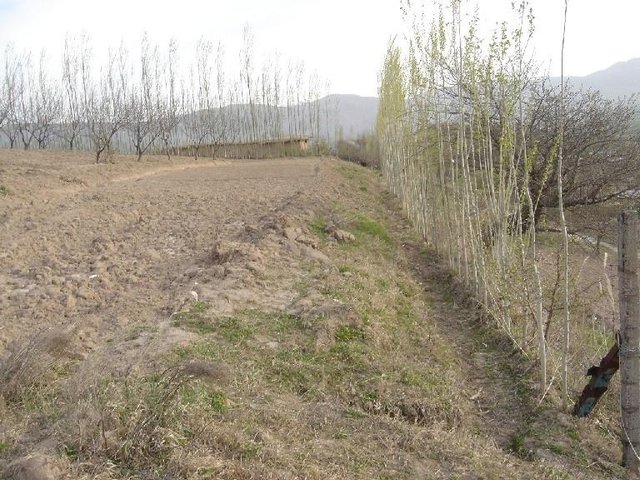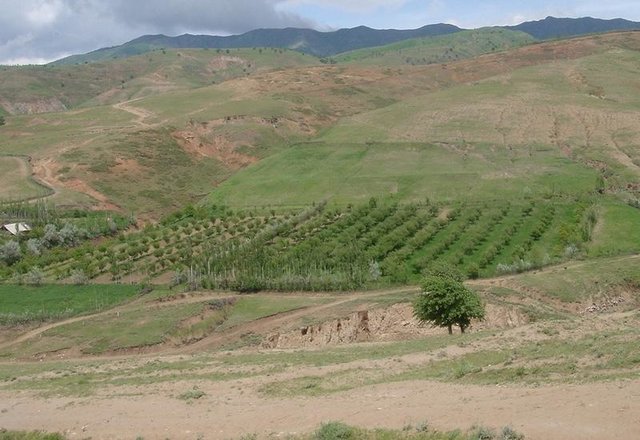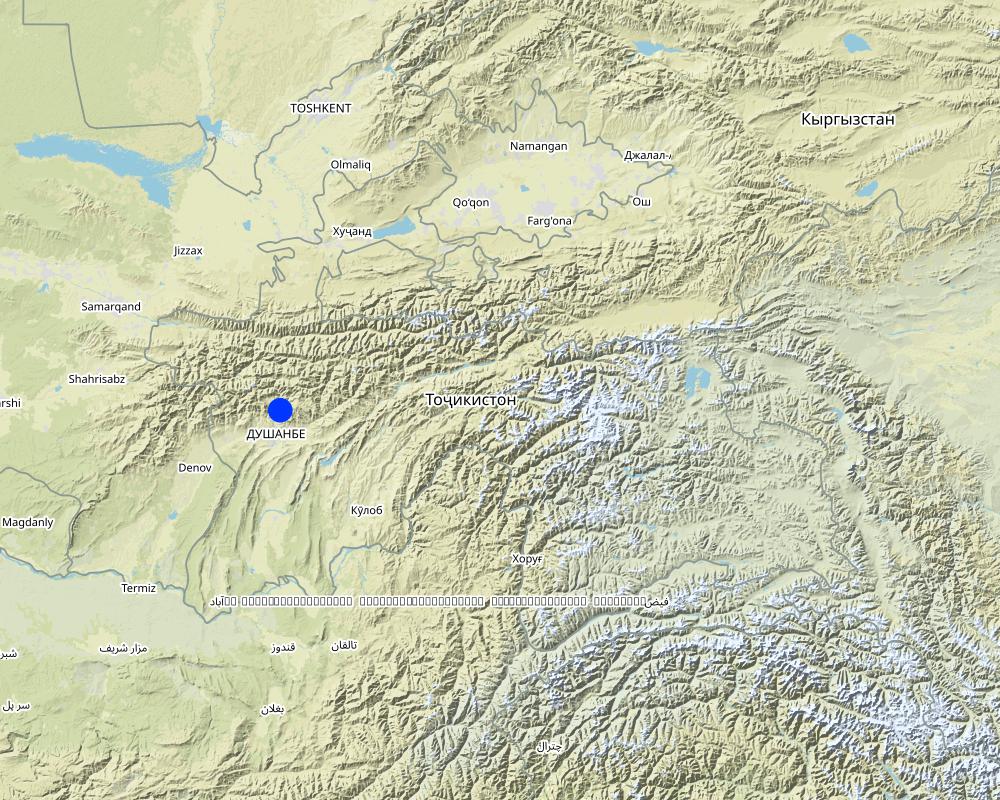Voluntary Labour Assistance [Tadjikistan]
- Création :
- Mise à jour :
- Compilateur : Erik Bühlmann
- Rédacteur : –
- Examinateurs : David Streiff, Alexandra Gavilano, Joana Eichenberger
approaches_2643 - Tadjikistan
Voir les sections
Développer tout Réduire tout1. Informations générales
1.2 Coordonnées des personnes-ressources et des institutions impliquées dans l'évaluation et la documentation de l'Approche
Nom du projet qui a facilité la documentation/ l'évaluation de l'Approche (si pertinent)
Pilot Program for Climate Resilience, Tajikistan (WB / PPCR)Nom du ou des institutions qui ont facilité la documentation/ l'évaluation de l'Approche (si pertinent)
NCCR North-South (NCCR North-South) - Kirghizistan1.3 Conditions relatives à l'utilisation par WOCAT des données documentées
Le compilateur et la(les) personne(s) ressource(s) acceptent les conditions relatives à l'utilisation par WOCAT des données documentées:
Oui
1.4 Références au(x) questionnaire(s) sur les Technologies de GDT

Terrace with Tree Barrier [Tadjikistan]
Forward sloping terraces stabilised with aligned poplar trees and adjacent grass strips
- Compilateur : Erik Bühlmann

Orchard-based Agroforestry (establishment of orchard) [Tadjikistan]
Establishment of an orchard intercropping system on severely degraded cropland.
- Compilateur : Erik Bühlmann
2. Description de l'Approche de GDT
2.1 Courte description de l'Approche
Voluntary labour assistance for labour intensive activities whereby community members help each other in contributing labour on the basis of mutual understanding.
2.2 Description détaillée de l'Approche
Description détaillée de l'Approche:
Aims / objectives: Members of the labour exchange group (often relatives and neighbours) can ask for assistance when labour intensive farm activities need to be performed. A farmer asks fellow land users individually for support. The request is made one or two weeks beforehand, informing individual farmers about the programme. During these informal land user exchanges, farmers share experiences and technical know-how on soil-and water conservation technologies and discuss details of the planned work. On the specified date, participants equip themselves with all necessary farm implements required for the activity. The farmer who seeks assistance should host the participants and prepare food and drinks. The objective of the approach is to alleviate labour shortages and to strengthen the relationship between community members.
2.5 Pays/ région/ lieux où l'Approche a été appliquée
Pays:
Tadjikistan
Région/ Etat/ Province:
RRS
Autres spécifications du lieu :
Faizabad
Map
×2.7 Type d'Approche
- traditionnel/ autochtone
2.8 Principaux objectifs de l'Approche
The Approach focused mainly on SLM with other activities (approach is used for all labour intensive activities, such as construction work, establishment of SWC technologies, harvesting etc.)
To overcome labour constraints.
The SLM Approach addressed the following problems: shortage of work force, since most farmers send their sons (or go themselves) to Russia to earn money.
2.9 Conditions favorisant ou entravant la mise en œuvre de la(des) Technologie(s) appliquée(s) sous l'Approche
disponibilité/ accès aux ressources et services financiers
- entrave
Lack of finance to hire labour
Treatment through the SLM Approach: mutual voluntary labour assistance is independent from the financial situation of land users
cadre juridique (régime foncier, droits d'utilisation des terres et de l'eau)
- entrave
The existing land ownership, land use rights / water rights moderately hindered the approach implementation Presently, all land in Faizabad Rayon is rented from the state. Farmers are often not willing to implement labour intensive SWC technologies if they do not own the land they farm.
autre
- entrave
Lack of able work force since many male villagers left to work in Russia.
Treatment through the SLM Approach: gathering of available work force to carry out labour intensive farming activities.
3. Participation et rôles des parties prenantes impliquées dans l'Approche
3.1 Parties prenantes impliquées dans l'Approche et rôles
- exploitants locaux des terres / communautés locales
Whilst decision making, planning and implementation of SWC technologies is mainly carried out by men, women assist mainly only for harvesting activities.
3.2 Participation des exploitants locaux des terres/ communautés locales aux différentes phases de l'Approche
| Participation des exploitants locaux des terres/ communautés locales | Spécifiez qui était impliqué et décrivez les activités | |
|---|---|---|
| initiation/ motivation | auto-mobilisation | |
| planification | auto-mobilisation | work is planned with advice of friends and elderly members |
| mise en œuvre | auto-mobilisation | |
| suivi/ évaluation | aucun | |
| Research | aucun |
3.4 Prises de décision pour la sélection de la Technologie/ des Technologies
Indiquez qui a décidé de la sélection de la Technologie/ des Technologies à mettre en œuvre:
- les exploitants des terres seuls (auto-initiative)
Expliquez:
Decisions on the method of implementing the SLM Technology were made by by land users* alone (self-initiative / bottom-up)
4. Soutien technique, renforcement des capacités et gestion des connaissances
4.1 Renforcement des capacités/ formation
Une formation a-t-elle été dispensée aux exploitants des terres/ autres parties prenantes?
Non
4.2 Service de conseils
Les exploitants des terres ont-ils accès à un service de conseils?
Oui
Spécifiez si le service de conseils est fourni:
- dans les champs des exploitants?
Décrivez/ commentez:
Name of method used for advisory service: Informal land user extensions
Advisory service is quite adequate to ensure the continuation of land conservation activities
4.3 Renforcement des institutions (développement organisationnel)
Des institutions ont elles été mises en place ou renforcées par le biais de l'Approche?
- non
4.4 Suivi et évaluation
Le suivi et l'évaluation font ils partie de l'Approche? :
Oui
Commentaires:
Economic / production aspects were ad hoc monitored by 0 through measurements; indicators: None
Area treated aspects were ad hoc monitored by 0 through observations; indicators: None
There were no changes in the Approach as a result of monitoring and evaluation: None
4.5 Recherche
La recherche a-t-elle fait partie intégrante de l’Approche?
Non
5. Financement et soutien matériel externe
5.1 Budget annuel de la composante GDT de l'Approche
Si le budget annuel précis n'est pas connu, indiquez une fourchette:
- < 2 000
Commentez (par ex. principales sources de financement/ principaux bailleurs de fonds):
Approach costs were met by the following donors: other (land user requesting for assistance): 100.0%
5.3 Subventions pour des intrants spécifiques (incluant la main d'œuvre)
Si la main d'œuvre fournie par les exploitants des terres était un intrant substantiel, elle était:
- volontaire
Commentaires:
The provision of food for voluntary assistance workers should be seen more as a part of traditional hospitality, rather than a food for work payment.
5.4 Crédits
Des crédits ont-ils été alloués à travers l'Approche pour les activités de GDT?
Non
5.5 Autres incitations ou instruments
D'autres incitations ou instruments ont-ils été utilisés pour promouvoir la mise en œuvre des Technologies de GDT?
Non
6. Analyses d'impact et conclusions
6.1 Impacts de l'Approche
Est-ce que l'Approche a aidé les exploitants des terres à mettre en œuvre et entretenir les Technologies de GDT?
- Non
- Oui, un peu
- Oui, modérément
- Oui, beaucoup
Through the approach, land users shared skills and knowledge, but could benefit from experiences of other farmers before establishment of an SWC technology.
Est-ce que l'Approche a amélioré les questions foncières et des droits d'utilisation qui entravent la mise en œuvre des Technologies?
- Non
- Oui, un peu
- Oui, modérément
- Oui, beaucoup
The approach eases the problem of labour shortages; the decision to implement substantial SWC technologies is still taken by the individual land user and his family. The problem is likely to be overcome in the near future. Awareness of land users about soil and water conservation can be increased through offering workshops and seminars. Improved SWC knowledge may lead to more sustainable land management through implementation of SWC technologies. However, in order to make fa..............
Did other land users / projects adopt the Approach?
- Non
- Oui, un peu
- Oui, modérément
- Oui, beaucoup
The approach has evolved and developed within a Tajik rural community. Labour assistance can be requested by any farmer who is willing to help others as well.
6.3 Durabilité des activités de l'Approche
Les exploitants des terres peuvent-ils poursuivre ce qui a été mis en œuvre par le biais de l'Approche (sans soutien extérieur)?
- oui
6.4 Points forts/ avantages de l'Approche
| Points forts/ avantages/ possibilités du point de vue de l'exploitant des terres |
|---|
| Eases the labour problem with very little costs. |
| Points forts/ avantages/ possibilités du point de vue du compilateur ou d'une autre personne ressource clé |
|---|
| Experiences and knowledge are shared. |
| Stronger social relationships among community members. |
| SWC technologies can be implemented more easily |
| Eases labour shortages. (How to sustain/ enhance this strength: The approach is sustainable in itself, as long as the approach is based on a mutual understanding.) |
| Farming activities can be carried out according to their seasonal calendar. |
6.5 Faiblesses/ inconvénients de l'Approche et moyens de les surmonter
| Faiblesses/ inconvénients/ risques du point de vue de l’exploitant des terres | Comment peuvent-ils être surmontés? |
|---|---|
| When assisting others, sometimes their own work cannot be carried out on time. |
| Faiblesses/ inconvénients/ risques du point de vue du compilateur ou d'une autre personne ressource clé | Comment peuvent-ils être surmontés? |
|---|---|
| If no means are available to host participants, farmers cannot request assistance. | |
| Only those farmers who have sufficient means to support other can participate in the approach. |
Liens et modules
Développer tout Réduire toutLiens

Terrace with Tree Barrier [Tadjikistan]
Forward sloping terraces stabilised with aligned poplar trees and adjacent grass strips
- Compilateur : Erik Bühlmann

Orchard-based Agroforestry (establishment of orchard) [Tadjikistan]
Establishment of an orchard intercropping system on severely degraded cropland.
- Compilateur : Erik Bühlmann
Modules
Aucun module trouvé


